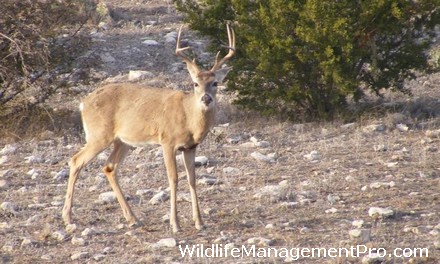Question: “We have been trying to improve the deer hunting on our property for about four or five years now. We started some wildlife habitat management practices and have started to keep survey records of the deer we see. We have tried deer food plots during the past several years, but because of the lack of rain, they have performed poorly. They are not helping the deer if they do not grow. Now we are considering the feeding of deer. So my question is, when should we start the supplemental feeding of protein pellets and when do the bucks need most and when will they benefit from it the most during their antler growth?”
Wildlife Management Pro: Feeding protein pellets really helps the body condition (i.e. weight) of whitetail deer. Bucks with better body condition grow larger antlers. Heavier does will raise more fawns. If you want to benefit bucks the most for antler growth, to grow bigger antlers, start supplementing as soon as possible after the rut, or at least after you are through deer hunting, each year. Bucks will readily consume high quality protein foods until spring green-up, then they will use the better stuff found growing in their habitat.

When habitat conditions decline, usually by early summer, deer will once again start visiting supplemental feed sites. For bucks, protein pellets contribute to antler growth for the following year starting after the rut all the way through July. The critical months would be January, February, June and July. During normal years, high quality natural forbs and browse (20 to 35% protein) are available during the months of March, April and May.
If you plan on feeding protein most of the year then I would encourage you to feed during August and mid-September too. It is at this time of the year that habitat conditions can be very bad due to lack of rain. Does that have inadequate nutrition at this time of year will abandon fawns if they can not produce enough milk to support them. The supplemental feeding of deer during the summer and early fall can really increase fawn numbers. Once temperatures cool, acorns drop, and we catch a couple cool season rains everyone will have plenty to eat heading into fall.
In short, the best time to supplemental feed for deer is when it’s really cold, really hot or just really dry. This is when the habitat is offering low quality foods and deer are looking for high quality foods. For antler growth you want to keep bucks on a high level of nutrition throughout the year if at all possible, so make sure it’s available to them when they need it. As you mentioned in your question, enhancing wildlife populations is also about habitat management, so make sure to strive to increase the quality and quantity of native forage too.